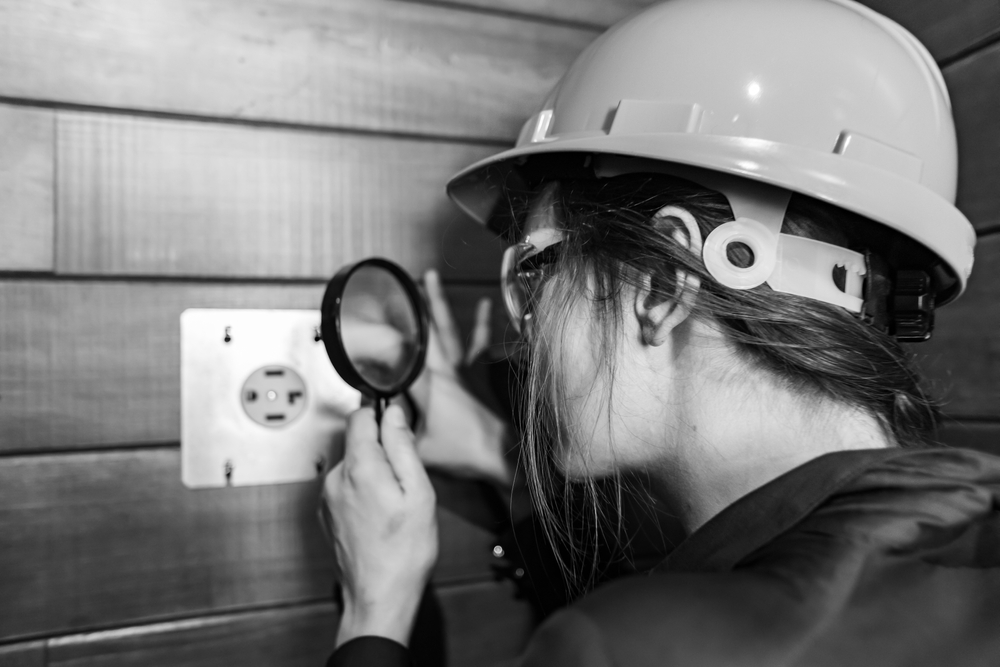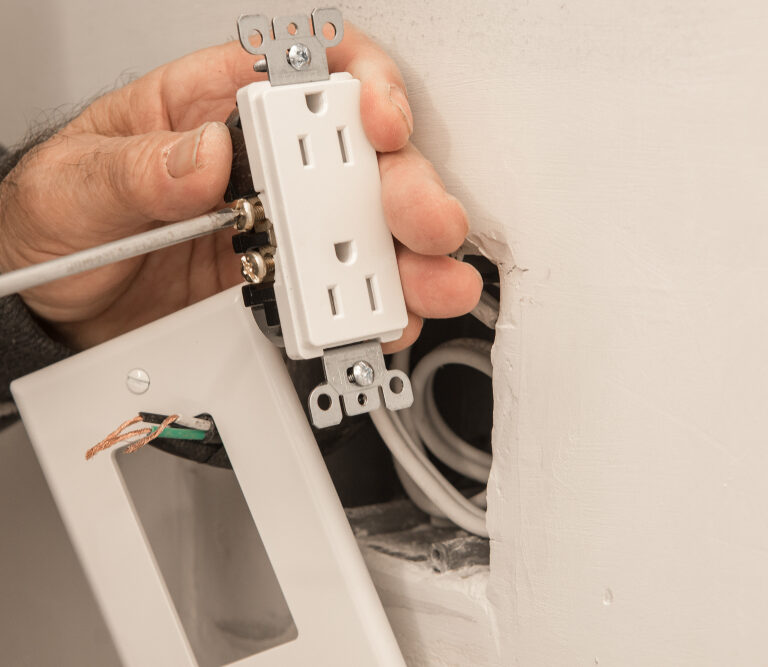Electrical outlets are something we all use every day without a second thought. Do you ever look at an outlet and contemplate how it works? Chances are, no.
If you’re looking to make some changes to your home’s electrical system, stick around. We’re going to explore what you need to know about many of the common electrical outlets found in your home. We’ll also look at less common specialty outlets that you may have seen but never used before.
Common Electrical Outlets
Let’s start off by taking a look at some modern outlets. Then we’ll look at some legacy outlets you may have seen, and explain why you should be glad we don’t use them anymore.
Duplex Outlets
Duplex outlets are the most common type of electrical outlet. These allow you to connect two plugs per receptacle. They come in a variety of amperage ratings, such as 15-amp and 20-amp receptacles.
Ground Fault Circuit Interrupter (GFCI) Outlets
Ground fault circuit interrupter (GFCI) outlets are receptacles that contain a GFCI. GFCIs break the flow of current when the device detects a ground fault.
Circuit breakers are usually equipped with GFCIs. But using a GFCI outlet can cut this dangerous flow of electricity before the breaker can detect it. Because of this, the National Electrical Code requires them in bathrooms and kitchens.
GFCI outlets are easy to distinguish from regular outlets. They feature two buttons on the face of the receptacle that allow you to test and reset the breaker.
What Is a Ground Fault?
A ground fault is when an electrical circuit malfunctions in a way that causes it to seek a grounding path outside its designated path. When a ground fault occurs, it allows the electricity to flow unrestricted. This allows for a dangerous increase in the amount of current passing through the wire.
What Causes Ground Faults to Happen?
There are a number of ways a ground fault can occur. The most common causes are faulty wiring, loose connections, and worn cable insulation. Having water in the receptacle can also cause a ground fault, which is why they’re required near sinks.
A ground fault can cause the current to make exposed metal on an appliance to become live. It can also cause the plug itself to become live. In both cases, this results in a high risk of electrocution or fire.
Arc Fault Circuit Interrupter (AFCI) Outlets
Arc fault current interrupter (AFCI) outlets are receptacles that contain an AFCI. An AFCI recognizes the unique characteristics that arching exhibits when it occurs. When it detects an arc fault, it breaks the current.
AFCI outlets are almost indistinguishable from GFCI outlets in appearance. They also even come combined into one outlet, like this one. Like GFCI outlets, they feature buttons on the face of the receptacle to test and reset the breaker.
What Is an Arc Fault?
An arc fault is an arcing condition that leads to a high discharge of electricity. This discharge of electricity leads to the generation of heat. This heat is usually high enough to cause nearby combustible materials to catch fire.
What Causes Arc Faults to Happen?
Arc faults can occur when plugs become corroded, or when wires sustain damage. Simple accidents, like pinching a wire under a piece of furniture or driving a nail through a wire, can cause an arc fault. Rodents chewing on wires inside the wall can also lead to arc faults.
As these things can happen without your knowledge, it’s impossible to completely eliminate the risk of an arc fault occurring. That’s where AFCIs come in.
But having arc fault protection is not only important to your safety – it’s also mandatory in some areas of the home.
You can do this by replacing the first outlet on a branch circuit with an AFCI outlet. In turn, this will protect the entire branch from dangerous arching.
Ungrounded Outlets
Ungrounded outlets are the last type of common outlet. As the National Electrical Code implements stricter regulations, ungrounded outlets are becoming antiquated. As houses built before the 1970s were not required to have grounding wire installed, this is where you’ll most commonly find them.
There are generally two types of ungrounded outlets found in older homes. Ungrounded unpolarized outlets are the first of the two.
What Are Ungrounded Unpolarized Outlets?
Ungrounded unpolarized outlets have two outlet slots that are the same size. One side is the “hot” side, while the other is the “neutral” side. The same goes for unpolarized plugs.
For some appliances, the neutral side connects to the outer casing. With unpolarized plugs, you could essentially wire the appliance backward without realizing it. This means that the shell of the appliance can become live, instead of remaining neutral. If you happened to touch a live appliance while being grounded, you could give yourself a fatal shock.
You might think the answer is to simply connect the plug properly. But unfortunately, it isn’t that simple. Short of having a voltmeter, it’s impossible for you to tell which side of the plug is hot, and which is neutral.
Why Do Ungrounded Unpolarized Outlets Exist?
Unpolarized outlets and plugs are not very common anymore. However, these outlets were common during the WWII era. This was due to relaxed electrical codes, as well as the fact that 100-watt light bulbs were the most common high-energy device in most homes.
However, as appliances became more accessible, the dangers of unpolarized outlets became clear. The NEC responded by mandating the use of polarized plugs and outlets.
What Are Ungrounded Polarized Outlets?
Polarized plugs and outlets made it to where outlets had two different-sized slots. The large slot is the neutral side, while the smaller slot was the hot side. This made it so you couldn’t wire appliances backward on accident.
Of course, having a polarized outlet doesn’t eliminate the possibility of accidental electrocution. It does, however, significantly reduce the risk.
Since grounding plugs became the standard, ungrounded polarized outlets have become less prevalent. Today, polarization is the standard for all outlets and plugs.
Now that we’ve covered the most common types of outlets, let’s take a look at specialty outlets.

Specialty Outlets
There are tons of different specialty outlets that go well beyond the scope of this article. Instead, we’re going to cover many of the most common types of specialty outlets. We’ll also look at a couple that have made their market debut in recent years.
30-Amp and 50-Amp Outlets
You know those weird 3 and 4-prong outlets that you sometimes see in laundry rooms and kitchens? Those are 30-amp and 50-amp outlets, and are sometimes referred to as 220v or 240v outlets.
These outlets provide a much greater amount of power than a standard duplex outlet. They’re specifically reserved for high-energy appliances, such as electric dryers and ranges.
Tamper-Resistant Receptacles
Since 2008, the National Electrical Code requires tamper-resistant receptacles for all new construction. Tamper-resistant receptacles are like regular duplex outlets, but they feature an interior shutter. Many modern outlets, including most specialty receptacles, come with tamper-resistant shutters.
These shutters block foreign objects from entering the slot. This makes them a perfect way to permanently childproof your home.
Combination Switch Receptacle
Combination switch receptacles are exactly what they sound like: a combination of an outlet and a switch on one receptacle. These types of switches are common in rooms that have overhead or nearby outdoor lights connected to them. You may also find them in garages, or other areas with limited circuitry available.
Switched and Switched-Split Outlets
Switched outlets use wall switches to control the power of a receptacle. Switched outlets usually connect to a single circuit, and operate both outlets. But there is another variation of switched outlet, called a switched-split outlet.
Switched-split receptacles use split-circuit receptacles to isolate the outlets from one another. This allows one outlet to stay on all the time, while the other only receives power when you flip the switch on.
You can usually find switched and switched-split outlets in living rooms and bedrooms. They’re useful for controlling floor and table lamps through the switch.
Weather-Resistant Outlets
As you may have guessed, weather-resistant outlets are commonly found in garages and outdoors. They’re useful for providing power for things like power tools and other outdoor equipment. For outlets on the exterior of your home, covers are often used to protect them when they aren’t in use.
Surge Suppression Receptacles
Surge suppression receptacles function much like a surge protector power strip does. Surge suppression receptacles are ideal for sensitive electronics, like computers and medical equipment.
Like surge protector strips, these receptacles have grounding and surge protection indicators. However, they can also feature audible alarms to indicate when surge protection expires.
Recessed Receptacles
Recessed receptacles sit inside the wall, keeping plugs from protruding from the wall. These are extremely useful for a wide variety of applications where space is a premium.
For example, recessed outlets are useful for wall-mounted TVs. They’re also useful in kitchens, where they can free up counter space by allowing appliances to sit closer to the wall.
Rotating Outlets
Rotating outlets are typically duplex receptacles that contain outlets that rotate. Rotating outlets are useful for large power supply cords that convert the current from AC to DC. They are a cleaner alternative to extension cords, and can reduce wire clutter.
USB Outlets
In the last couple of decades, USB technology has become an increasingly important part of society. Many portable and low-powered devices use USB to provide power and charging capabilities. However, in order to use USB with a wall outlet, you need an adapter. That is, unless you have a USB wall outlet.
USB wall outlets provide built-in USB ports. They allow you to charge your devices without needing a big clunky adapter.
Traditionally, these USB wall outlets are made with USB-A ports. However, as USB-C ports are becoming more common, USB outlets with USB-C ports have become available. With USB-C’s superior charging speeds and frustration-free design, it’s easy to see why.
If you’re looking to modernize your home, picking up a few USB outlets is a good way to go.
Smart Wall Outlets
Speaking of modernizing, perhaps the newest and most interesting type of outlet on the market is the smart wall outlet. Smart wall outlets, like smart plugs, allow you to use your phone or voice to turn the outlet on or off. That means you can simply tell your lamp to turn on or off, and it’ll do it. Pretty neat, huh?
Of course, there are disadvantages to smart outlets that smart plugs don’t have. Chief among them is the difficulty of replacing them if they stop working.
So with this in mind, you might wonder why you’d go with smart wall outlets when smart plugs exist?
Well, if you need a smart plug that has a space-saving design, smart outlets are the way to go. While smart plugs are getting smaller, even the sleekest smart plugs can’t compete.
Finishing Up
We’ve looked at the most common types of electrical outlets today. We also looked at a couple from the past, and delved into some common specialty outlets. Now, you should have a pretty good idea as to what the different types of outlets in your home are, and how they work.
Just remember: if you plan on making any upgrades to your electrical system, consider hiring a professional. Saving a few bucks by doing it yourself is not worth the potential hazard to you or your home.
